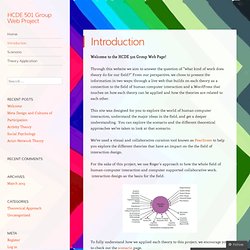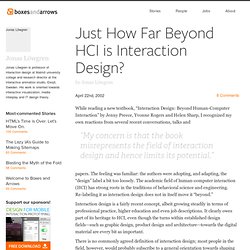

Introduction to HCDE 501 Group Web Project. Welcome to the HCDE 501 Group Web Page!

Through this website we aim to answer the question of “what kind of work does theory do for our field?” From our perspective, we chose to present the information in two ways: through a live web that builds on each theory as a connection to the field of human computer interaction and a WordPress that touches on how each theory can be applied and how the theories are related to each other. This site was designed for you to explore the world of human computer interaction, understand the major ideas in the field, and get a deeper understanding. You can explore the scenario and the different theoretical approaches we’ve taken to look at that scenario. Just How Far Beyond HCI is Interaction Design? While reading a new textbook, “Interaction Design: Beyond Human-Computer Interaction” by Jenny Preece, Yvonne Rogers and Helen Sharp, I recognized my own reactions from several recent conversations, talks and papers.

The feeling was familiar: the authors were adopting, and adapting, the “design” label a bit too loosely. The academic field of human-computer interaction (HCI) has strong roots in the traditions of behavioral science and engineering. Re-labeling it as interaction design does not in itself move it “beyond.” Interaction design is a fairly recent concept, albeit growing steadily in terms of professional practice, higher education and even job descriptions. It clearly owes part of its heritage to HCI, even though the turns within established design fields—such as graphic design, product design and architecture—towards the digital material are every bit as important.
Actor-Network Theory. Cognitive Theory. Ethnomethodology. Distributed Cognition. Social Psychology. Activity Theory. Semiotic Engineering.